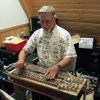C#m7 vs E6 tuning
Moderator: Brad Bechtel
-
Allan Revich

- Posts: 1249
- Joined: 2 Nov 2018 7:04 pm
- Location: Victoria, BC
C#m7 vs E6 tuning
Seems like every other m7 tuning is called by its enharmonic X6 equivalent, (ie, C6/Am7, G6/Em7) why do we call this particular E6, C#m7?
E B E G# C# E
Is it just because that’s how the first person who publicized it labeled it, or is there a reason rooted in music theory?
E B E G# C# E
Is it just because that’s how the first person who publicized it labeled it, or is there a reason rooted in music theory?
-
Ian Rae

- Posts: 6164
- Joined: 10 Oct 2013 11:49 am
- Location: Redditch, England
With E at the bottom it's E6.
No reason to call it C#m7.
In practice the two chords are interchangeable, but when describing a tuning one should acknowledge the root.
No reason to call it C#m7.
In practice the two chords are interchangeable, but when describing a tuning one should acknowledge the root.
Make sleeping dogs tell the truth!
Homebuilt keyless U12 7x5, Excel keyless U12 8x8, Williams keyless U12 7x8, Telonics rack and 15" cabs
Homebuilt keyless U12 7x5, Excel keyless U12 8x8, Williams keyless U12 7x8, Telonics rack and 15" cabs
-
Allan Revich

- Posts: 1249
- Joined: 2 Nov 2018 7:04 pm
- Location: Victoria, BC
I agree...but nevertheless, this tuning is known as C#7 in the Lap Steel world. And that’s why I’ve posed the question.Ian Rae wrote:With E at the bottom it's E6.
No reason to call it C#m7.
In practice the two chords are interchangeable, but when describing a tuning one should acknowledge the root.
http://www.scottysmusic.com/tunings.htm

Then there’s this thread
viewtopic.php?t=204049
And
https://www.hawaiiansteel.com/tunings/master.php
(Mis-named here though - C#m7 is labeled as C#m, and the chord labeled C#m7 is actually E13 I think (no D in a C#m7))
-
Dave Mudgett

- Moderator
- Posts: 10456
- Joined: 16 Jul 2004 12:01 am
- Location: Central Pennsylvania and Gallatin, Tennessee
To me, the tuning root is whatever you want it to be for the situation in which you're playing. I pretty routinely see these tunings referred to both ways. I think the distinction is a bit more clear on 8-string, which is where I more often see the distinction made (low-hi):
Low E6/C#m7:
High E6/C#m7:
Multiple views of a tuning are also implicit with other tunings, including standard pedal steel C6:
C6/Fmaj13 (lo-hi):
In fact, a lot of pedal steel C6 is played out of the F root - it's an important facet of playing that tuning.
Low E6/C#m7:
Code: Select all
C#m7 E(b3) G#(5) B(b7) C#(1) E(b3) G#(5) C#(1) E(b3)
E6-v2 E(1) G#(3) B(5) C#(6) E(1) G#(3) C#(6) E(1) (same as C#m7)Code: Select all
C#m7 G#(5) B(b7) C#(1) E(b3) G#(5) C#(1) E(b3) G#(5)
E6-v2 G#(3) B(5) C#(6) E(1) G#(3) C#(6) E(1) G#(3) (same as C#m7)Multiple views of a tuning are also implicit with other tunings, including standard pedal steel C6:
C6/Fmaj13 (lo-hi):
Code: Select all
C6: C(1) F(4) A(6) C(1) E(3) G(5) A(6) C(1) E(3) G/D(5/2)
Fmaj9/Fmaj13: C(5) F(1) A(3) C(5) E(7) G(9) A(3) C(5) E(7) G/D(9/13)-
Guy Cundell

- Posts: 934
- Joined: 31 Jul 2008 7:12 am
- Location: More idle ramblings from South Australia
Allan, I have researched and written about the tuning in two studies, 'Across the Pacific' in 2014 and more extensively in 'Across the South' Ch4, last year.
The name has historical significance rather than theoretical. Yes, it is E6, but whenever I see C#m mentioned, I expect the perfect 4th interval between strings 2 & 3 which sets the tuning apart, along with F#9, both with origins in the early 1930s.
https://guycundell.academia.edu/research
The name has historical significance rather than theoretical. Yes, it is E6, but whenever I see C#m mentioned, I expect the perfect 4th interval between strings 2 & 3 which sets the tuning apart, along with F#9, both with origins in the early 1930s.
https://guycundell.academia.edu/research
-
Allan Revich

- Posts: 1249
- Joined: 2 Nov 2018 7:04 pm
- Location: Victoria, BC
-
Erv Niehaus

- Posts: 27142
- Joined: 10 Aug 2001 12:01 am
- Location: Litchfield, MN, USA
-
Allan Revich

- Posts: 1249
- Joined: 2 Nov 2018 7:04 pm
- Location: Victoria, BC
Dadf#bd — D6
I’m finding that I prefer this tuning down a step, to D6. Mostly because minor keys seem to fall more naturally on the fretboard with B as the open minor instead of C#